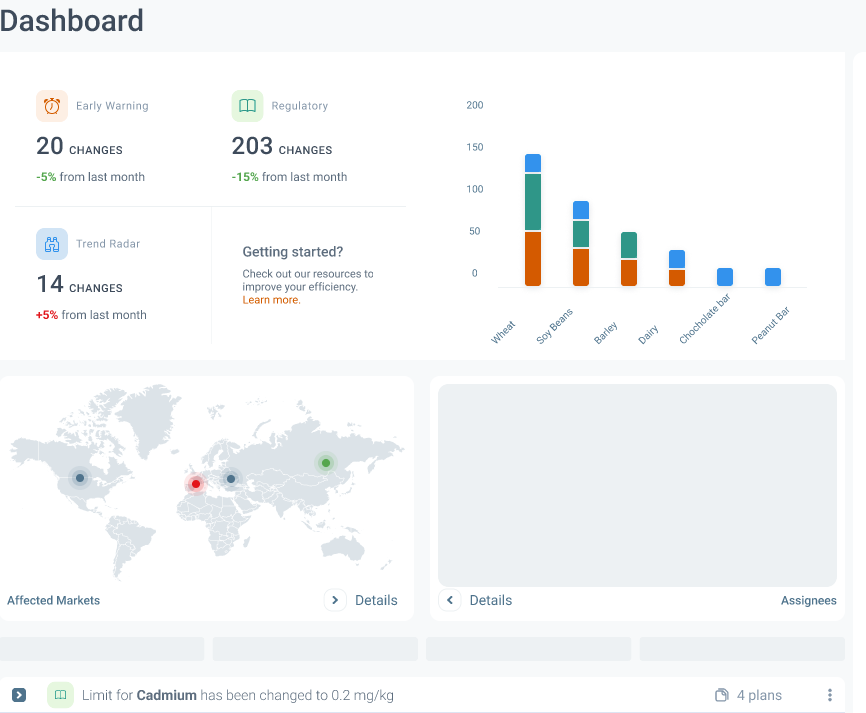On May 5th, the new contaminant regulation (EU) 2023/915 was published. This came into force on May 25th, 2023 and will replace the previous regulation (EC) 1881/2006.
This new regulation was planned for a long time and should present the contents more clearly through a new structure and integration of the many footnotes.
Key changes
The definitions of key terms such as "food", "food business operator", and others have been established in Article 1.
In addition, a basic detoxification ban has been introduced for all foods containing contaminants listed in Annex I - chemical treatments may not be used to intentionally remove these harmful substances from the product. In Regulation (EC) 1881/2006, the restriction was applied only to mycotoxins.
In regards to maximum limits for certain contaminants present within specific foods, transitional measures are now put into place with Art.10 outlining their placement onto markets accordingly.
Furthermore, melamine contamination levels have also received attention under new European standards following the publication by the Codex Alimentarius regarding liquid infant formulae's acceptable limit amounts.
The limits for some contaminants have also been adjusted or added. In Annex I you will find new limits for Mycotoxins (Aflatoxins, Ochratoxin A, Patulin, Deoxynivalenol, Zearalenone, Fumonisins, Citrinin, Ergot sclerotia and ergot alkaloids), Plant toxins (Erucic acid, including erucic acid bound in fat, Tropane alkaloids, Hydrocyanic acid, including hydrocyanic acid bound in cyanogenic glycosides, Pyrrolizidine alkaloids, Opium alkaloids, Delta-9-tetrahydrocannabinol (Δ9-THC) equivalents), Metals and other elements (Lead, Cadmium, Mercury, Arsenic, Tin (inorganic)), Halogenated persistent organic pollutants (Dioxins and PCBs, Perfluoroalkyl substances), Processing contaminants (Polycyclic aromatic hydrocarbon (PAHs), 3-monochloropropane-1,2-diol (3-MCPD), Sum of 3-monochloropropanediol (3-MCPD) and 3-MCPD fatty acid esters, expressed as 3-MCPD, Glycidyl fatty acid esters, expressed as glycidol), other Contaminants (Nitrates, Melamine, Perchlorate).
For the sum of aflatoxins, maximum levels refer to lower bound concentrations, which are calculated on the assumption that all the values below the limit of quantification are zero.
Follow the changes easily with SGS DIGICOMPLY Smart Test Protocol
To stay updated on all the changes, we suggest utilizing SGS DIGICOMPLY Smart Test Protocol, an advanced AI-driven solution that streamlines the process and keeps you well-informed about all regulatory updates. This innovative tool assists clients in tackling the key challenges of food surveillance programs, including complexity, frequent changes, cost, and prioritizing risks.
To facilitate the management of test plan updates, we have developed a comprehensive dashboard that categorizes the updates into three sections: early warning, regulatory, and trend radar.
-
Early warning: This section covers all updates related to food safety, incidents, and SGS laboratory data.
-
Regulatory: This section includes all updates related to regulations, such as (EU) 2023/915.
-
Trend Radar: This section focuses on changes that may impact materials in the future, including scientific publications, NGO reports, and SGS laboratory data.
Each section provides a prioritized overview of actions to consider, along with the test plans that are affected by each update. Moreover, the affected markets are visually represented on a map, and you can utilize the AI Co-pilot to guide you through the necessary tasks.

This update builds upon the previous article, thanks to the fresh insights gained from SGS DIGICOMPLY Smart Test Protocol.





.webp?width=1644&height=1254&name=Food%20Safety%20Dashboard%201%20(1).webp)
